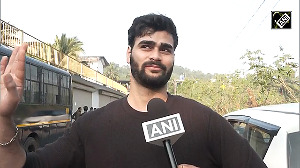"The Karakoram highway is China's property," said Professor Wang Dehua, director, South Asia Studies at the Shanghai Academy of Social Sciences when asked about India's recent objection for Chinese assistance to Pakistan in upgrading it.
The professor who is on a lecture tour to India suggests that the issue of upgrading Karakoram highway is in public domain since 2006 and the Indian government is well-aware of the plans but they never objected it through the media.
Talking about ongoing critical write-ups in Indian media against China he thinks that Indian media is not reflecting correct position of both sides, particularly historical facts.
K Subrahamanyam, strategic guru, dismisses Professor Wang's assertion and says that Karakoram is not Chinese territory since it starts in Pakistan Occupied Kashmir and India's stand over it is well-known.
The highway passes through PoK's Gilgit-Baltistan and reaches Kashgar in Xinjiang in China. Last week, India had sharply protested against China and Pakistan's plan to upgrade the Karakoram highway and the Neelam-Jhelum hydroelectric project in PoK.
During a meeting with Pakistan Prime Minister Yousuf Raza Gilani on October 13, the Chinese President Hu Jintao committed Chinese assistance to upgrade the highway which is strategically crucial for China.
Srikanth Kondapalli, head of China studies at the Jawaharlal Nehru University, told rediff.com, "When the Karokoram highway was built in 1954-1957, India had objected to it. Since then Chinese made it de jure. They are neither reacting nor discussing it with us. In 1963, Pakistan gifted 4,853 square km of Shakshgam valley to China and again they are not talking about it nor taking into account Indian protests. The agreement between them was that Shakshgam's transfer is subject to the final outcome of the Kashmir issue. The current agreement violates the older understanding of 1963."
"What was being talked privately is now talked about in open by both countries," he says.
Another, New Delhi-based China expert believes that both sides have working groups on different issues and disputes were debated in closed rooms all these years but, now the media has made the issues public without carrying its nuances in public debates."
Both sides are freely indulging in blame games. A classic example of it was seen on October 14 when China's People's Daily wrote an opinion piece titled 'Indian hegemony continues to harm relations with neighbours' in which the Chinese commentator labelled India as arrogant and reckless. 'To everyone's disappointment, India pursued a foreign policy of befriend the far and attack the near,' the commentator alleged.
In New Delhi, there are multiple views about China's not just strident but serious diplomatic attacks against India and also about Indian media's hype over the issues but still, nobody doubts that the rhetoric between two countries is different than normal times.
Is Chinese government's rising voice over the different issues and India's equally strident protest merely a proforma protest or something more than that?
Subrahamanyam, who has written many sharp columns on how to cope with a rising China, forcefully argues that 2009 is not 1962 and that the media on both sides is largely hawkish and jingoistic. However, he believes that, "Chinese policies towards India have subtle elements of sophisticated coercion to attempt to prevent a closer partnership developing between India and the US. China may also have plans to shape a final settlement of the Tibetan issue on the passing of the present Dalai Lama."
When asked what message Beijing wants to send through its tough stand, Subrahmanyam said, "China is waiting for Dalai Lama to die! They will find a 'reincarnation' of the Dalai Lama and would like to install him. They will train him and ensure a transition. They do not want Tibetans in India to create any trouble. They will keep India on its toes till the installation is over."
Subrahamanyam's assumption is largely based on the belief that once 'new' Dalai Lama is installed by Chinese government the Tibet chapter will be closed for China.
Kondapalli thinks that, "This is a perception from China's side. India doesn't think on this line. India sees current tension between India and China as a 'land' issue."
"Beijing wants to send us the message that whatever land we have we will develop. Physical ownership is final for us and whatever you have we term it as disputed."
Kondapalli says, "The issue of installing the Dalai Lama is just one issue. Regardless of the Dalai Lama, 'land' is the issue. China has subdued Taiwan, Vietnam and Japan. It has an important role in the G-2 framework. China is entering a new phase. Chinese nationalism is directed against India these days. The protests from both sides may be proforma in nature but China's stand on Kashmir indicates that things are changing."
When Prime Minister Manmohan Singh meets Chinese Premier Wen Jiabao at the ASEAN summit in Thailand on October 24, it will obviously focus on the sharpening rhetoric between India and China. Subrahamanyam says, "Both leaders are likely to agree to co-exist peacefully. They will try to keep border issues in cold storage and deal with issues like trade."
Kondapalli says, "There is no reason to be concerned about Chinese tough stand because I believe India and the army is prepared to face the Chinese."






